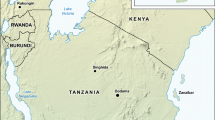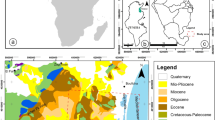Abstract
Well field Heel, in the south east of the Netherlands, consists of a row of wells drilled in an anoxic pyrite-containing aquifer alongside a former gravel pit, which now serves as a recharge basin, where water is actively aerated. All wells are seriously affected by chemical (screen slot) and/or mechanical (well bore) clogging. The objective of this study is to explain this combined occurrence. A combination of chemical, hydraulic and well-maintenance data indicate three groundwater quality types: (1) oxic basin water, (2) anoxic iron-containing basin water after oxidation of the traversed aquifer, and (3) deeply anoxic native groundwater. Wells abstracting a mixture of oxic basin water and anoxic basin water and/or native groundwater experience chemical well clogging, whereas wells abstracting (only or partly) native groundwater are vulnerable to mechanical well clogging. In the end, after oxic basin water has completely oxidized the traversed the aquifer, only two groundwater quality types will be present. Wells abstracting only oxic basin water will show no clogging, and wells abstracting a mixture of native groundwater and oxic basin water will experience chemical and possibly also mechanical well clogging. In this reasoning, the sequence in abstracted groundwater quality types coincides with a sequence in well clogging: from mechanical to chemical to no clogging. As well field Heel is situated in sloping terrain, the interplay between regional hydraulic gradient and different water qualities results in one-sided chemical clogging in the upper part of the well screen during abstraction, and in the lower part during the resting phase.
Résumé
Le champ captant d’Heel, dans le sud-est des Pays-Bas, se compose d’une rangée de puits forés dans un aquifère anoxique renfermant de la pyrite à côté d’une ancienne gravière, qui sert actuellement de bassin de recharge, où l’eau est activement aérée. Tous les puits sont sérieusement affectés par un colmatage chimique (au niveau des crépines) et/ou mécanique (puits de forage). L’objectif de cette étude est d’expliquer cette occurrence combinée. Une combinaison de données chimiques, hydrauliques et de l’entretien des puits indiquent trois type de qualité d’eaux souterraines : (1) une eau oxique du bassin, (2) une eau anoxique contenant du fer du bassin après oxydation de l’aquifère traversé, (3) les eaux souterraines originelles profondément anoxiques. Les puits prélevant un mélange d’eau oxique du bassin et d’eau anoxique du bassin et/ou d’eaux souterraines originelles sont affectés par un colmatage chimique des puits, alors que les puits ne prélevant (seulement ou partiellement) des eaux souterraines originelles sont vulnérables au colmatage mécanique. En fin de compte, après que l’eau du bassin oxygéné ait complétement oxydée l’aquifère traversé, seuls deux types de qualité d’eaux souterraines seront présents. Les puits prélevant uniquement des eaux du bassin oxygéné ne vont pas montrer de colmatage, et les puits prélevant un mélange d’eaux souterraines originelles et d’eau oxygénée du bassin vont être affectés par un colmatage chimique voir possiblement également mécanique. En suivant ce raisonnement, le séquençage des types de qualité des eaux souterraines prélevées coïncide avec un séquençage dans le type de colmatage des puits : du colmatage mécanique à chimique à aucun colmatage. Vu que le champ captant d’Heel est situé sur un terrain en pente, l’interaction du gradient hydraulique régional avec les différentes qualités d’eau a pour conséquence un colmatage chimique dans la partie supérieure crépinée du puits lors des prélèvements, et dans la partie inférieure pendant la phase de repos.
Resumen
El campo de pozos de Heel, en el sureste de Holanda, se compone de una fila de pozos perforados en un acuífero anóxico que contiene pirita junto a una antigua cantera de gravas, que ahora sirve como una cuenca para la recarga, donde el agua se airea activamente. Todos los pozos se ven seriamente afectados por productos químicos (ranura de los filtros) y/o por la obstrucción mecánica (pozo). El objetivo de este estudio es explicar este fenómeno combinado. Una combinación de datos químicos, hidráulicos y de mantenimiento de los pozos indican tres tipos de calidad del agua subterránea: (1) agua óxica de la cuenca, (2) agua anóxica de la cuenca que contiene hierro después de la oxidación en el acuífero atravesado, y (3) agua subterránea nativa profundamente anóxica. Los pozos que extraen una mezcla de agua subterránea óxica de la cuenca, agua anóxica de la cuenca y/o agua anóxica nativa experimentan una obstrucción química, mientras que los pozos que extraen (sólo o en parte) agua subterránea nativa son vulnerables a una obstrucción mecánica así. Al final, después que el agua óxica de la cuenca ha oxidado por completo el acuífero atravesado, sólo dos tipos de calidad de las aguas subterráneas estarán presentes. Los pozos que extraen sólo agua óxica de la cuenca única no mostrarán ninguna obstrucción y los pozos que extraen una mezcla de agua subterránea nativa y agua óxica de la cuenca posiblemente experimentarán la obstrucción química y mecánica. En este razonamiento, la secuencia de los tipos de calidad del agua subterránea extraída coincide con una secuencia en la obstrucción: desde mecánica a química a no obstrucción. Como el campo de bombeo de Heel está situado en la pendiente del terreno, la interacción entre gradiente hidráulico regional y las diferentes tipos de calidades de agua resultan en la obstrucción química unilateral en la parte superior de los filtros de los pozos durante la extracción, y en la parte inferior durante la fase de reposo.
摘要
荷兰东南部的Heel井场由一排井组成,这些井贯穿以前砾石矿坑旁边缺氧的含黄铁矿含水层,砾石矿坑现在成为了补给盆地,常常充满着水。所有的井受到了化学(滤水管槽)堵塞及/或机械(井孔)堵塞。本项研究的目的就是解释这两种情况一起出现的原因。化学、水力及井维护综合资料表明了三个地下水水质类型:(1)含氧盆地水;(2)横贯盆地的含水层氧化后的缺氧含铁盆地水;(3)深层缺氧本地地下水。抽取有氧盆地水和缺氧盆地水及/或本地地下水混合水的井经历着化学上的井堵塞,而(只或部分)抽取本地地下水的井易受到机械上的井堵塞。最后,有氧盆地水完全氧化了横穿盆地的含水层之后,就剩下了两个地下水水质类型。只抽取有氧盆地水的井不显示堵塞,抽取本地地下水和有氧盆地水混合水的井会经历化学上的堵塞及可能也经历机械上的堵塞。在这个推理中,抽取的地下水水质类型的序列与井堵塞的序列(机械上的堵塞—化学上的堵塞—无堵塞)一致。因为Heel井场位于有坡度的地势上,区域水力梯度和不同水质之间的相互作用导致抽水期间井滤水管上部及非抽水期间井滤水管下部一边倒的化学上的堵塞。
Resumo
O campo de poços de Heel, no sudeste dos Países Baixos, consiste em uma sequência de poços perfurados em um aquífero anóxico contendo pirita ao lado de uma antiga cava de cascalho, que atualmente serve como bacia de recarga, onde a água está ativamente gaseificada. Todos os poços são seriamente afetados por colmatação química (ranhura do filtro) e/ou mecânica (furo do poço). O objetivo desse estudo é explicar essa ocorrência combinada. A combinação de dados sobre a química, hidráulica e manutenção do poço, indicam três qualidades da água subterrânea: (1) água óxica da bacia (2) água da bacia anóxica contendo ferro após oxidação do aquífero atravessado, e (3) água subterrânea nativa anóxica. Os poços bobeiam a mistura de águas anóxicas e óxicas da bacia e/ou águas subterrâneas nativa, enfrentando colmatação química do poço, enquanto poços bombeando (somente ou parcialmente) a água subterrânea nativa são vulneráveis à colmatação mecânica. Ao final, após água óxica da bacia ter oxidado completamente o aquífero atravessado, apenas duas qualidades das águas subterrâneas estão presentes. Os poços que bombeiam apenas a água óxica da bacia, não deverão mostrar colmatação, e poços que absorvem a mistura de água subterrânea nativa e água óxica da bacia deverão mostrar uma probabilidade química ou mecânica de colmatação. Neste raciocínio, as sequências de tipos de qualidade das águas subterrâneas coincidem com a sequência em poços obstruídos: de mecânica para química, para nenhuma colmatação O campo de poços Heel está situado em um terreno inclinado, a interação entre gradiente hidráulico regional e diferentes qualidades da água resultam na obstrução química na parte superior do filtro durante o bombeamento, e na parte mais baixa durante a fase de recuperação.







Similar content being viewed by others
References
Appelo CAJ, Postma D (2005) Geochemistry, groundwater and pollution, 2nd edn. Balkema, Rotterdam, The Netherlands
Bustos Medina DA, van den Berg GA, van Breukelen BM, Juhasz-Holterman M, Stuyfzand PJ (2013) Iron-hydroxide clogging of public supply wells receiving artificial recharge: near-well and in-well hydrological and hydrochemical observations. Hydrogeol J 21(7):1393–1412. doi:10.1007/s10040-013-1005-0
Chanudet V, Filella M (2006) A non-perturbing scheme for the mineralogical characterization and quantification of inorganic colloids in natural waters. Env Sc Techn 40:5045–5051. doi:10.1021/es060255y
de la Loma Gonzalez B, van Beek CGEM, Hubeek AA, Kessels WTJ (2012) Description of well clogging after 10 years artificial recharge at well field Heel (WML). KWR report BTO 2012.036, KWRWATER, Nieuwegein, The Netherlands
Houben GJ, Treskatis C (2007) Water well rehabilitation and reconstruction. McGraw-Hill, New York, 391 pp
Houben GJ, Weihe U (2010) Spatial distribution of incrustations around a water well after 38 years of use. Groundwater 48(1):53–58. doi:10.1111/j.1745-6584.2009.00641.x
Howsam P, Misstear B, Jones C (1995) Monitoring, maintenance and rehabilitation of water supply boreholes. CIRIA, London
Kölle W, Strebel O, Böttcher J (1990) Reduced sulphur compounds in sandy aquifers and their interactions with groundwater. IAHS Publ. no. 173, Proc. IAHS Dresden Symp., March 1987, pp 23–30
Krems G (1972) Studie über die Brunnenalterung, Im Auftrage des Bundesministerium des Innern [Study on well aging, on behalf of the Federal Ministry of the Interior]. Unterabteilung Wasserwirtschaft, Berlin, 128 pp
Kretzschmar R, Borkovec M, Grolimund D, Elimelech M (1999) Mobile subsurface colloids and their role in contaminant transport. Adv Agr 66:121–194
McCarthy JF, Degueldre C (1993) Sampling and characterization of colloids and particles in ground water for studying their role in contaminant transport, chap 6. In: Buffle J, van Leeuwen HP (eds) Environmental particles, Lewis, Boca Raton, FL, pp 247–315
McDowell-Boyer LM, Hunt JR, Sitar N (1986) Particle transport through porous media. Water Resour Res 22(13):1901–1921. doi:10.1029/WR022i013p01901
McLaughlan R (2002) Managing water well deterioration. IAH International Contributions to Hydrogeology 22. Balkema, Dordrecht, The Netherlands
Postma D, Boesen C, Kristiansen H, Larsen F (1991) Nitrate reduction in an unconfined sandy aquifer: water chemistry, reduction processes, and geochemical modeling. Water Resour Res 27(8):2027–2045. doi:10.1029/91WR00989
Smith SA, Comeskey AE (2010) Sustainable wells, maintenance, problem, prevention, and rehabilitation. CRC, Boca Raton, FL
Vaidya RN, Fogler HS (1990) Fines migration and formation damage: influence of pH and ion exchange. SPE-19413-PA, SPE, Tulsa, OK, pp 325–330
van Beek, CGEM (1980) A model for the induced removal of iron and manganese from groundwater in the aquifer. In: Brataschuk J, Cole J (eds) Proc. 3rd Water–Rock Interaction Symp., Edmonton, AB, Canada, pp 29–31
van Beek CGEM (1982) Rehabilitation of clogged abstraction wells (in Dutch). H2O 15(15):370–377
van Beek CGEM (1985) Experiences with underground water treatment in the Netherlands. Water Supply 3(Berlin B):1–11
van Beek CGEM (2000) Redox processes active in denitrification, chap 12. In: Schüring J, Schulz HD, Fischer WR, Böttcher J, Duijnisveld WHM (eds) Redox, fundamentals, processes and applications. Springer, Berlin
van Beek K (2010) Cause and prevention of clogging of wells abstracting groundwater from unconsolidated aquifers. PhD Thesis, VU University, Amsterdam
van Beek CGEM, Breedveld RJM (2007) Lecture notes course ‘well maintenance’. World Water Academy, Nieuwegein, The Netherlands
van Beek CGEM, Breedveld RJM, Juhász-Holterman M, Oosterhof A, Stuyfzand PJ (2009a) Cause and prevention of well bore clogging by particles. Hydrogeol J 17:1877–1886. doi:10.1007/s10040-009-0537-9
van Beek CGEM, Breedveld RJM, Stuyfzand PJ (2009b) Prevention of two types of well clogging (requires two types of well operation). J AWWA 101(4):125–134
van Beek CGEM, de Zwart AH, Balemans M, Kooiman JW, van Rosmalen C, Timmer H, Vandersluys† J, Stuyfzand PJ (2010) Concentration and size distribution of particles in abstracted groundwater. Water Res 44(3):868–878. doi:10.1016/j.watres.2009.09.045
Acknowledgements
The help of Diego Bustos Medina in making his figures and insights of well field Heel available is very much appreciated, as is the help of Sjaak Kleuskens (WML) and Har Peeters (WML) in the field work, and of Wim Kessels (WML) in sharing his experience with well clogging at well field Heel. The report has benefitted from the constructive comments by the associate editor and the reviewers.
Author information
Authors and Affiliations
Corresponding author
Rights and permissions
About this article
Cite this article
van Beek, C.G.E.M., Hubeek, A.A., de la Loma Gonzalez, B. et al. Chemical and mechanical clogging of groundwater abstraction wells at well field Heel, the Netherlands. Hydrogeol J 25, 67–78 (2017). https://doi.org/10.1007/s10040-016-1469-9
Received:
Accepted:
Published:
Issue Date:
DOI: https://doi.org/10.1007/s10040-016-1469-9




